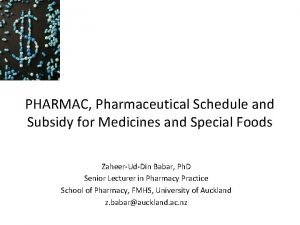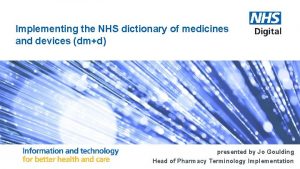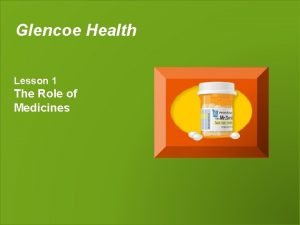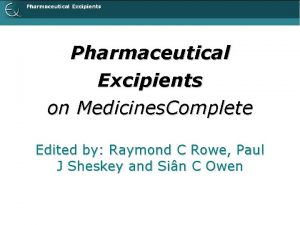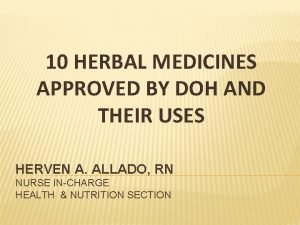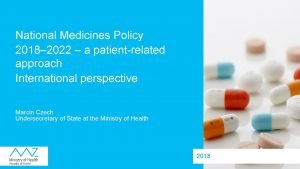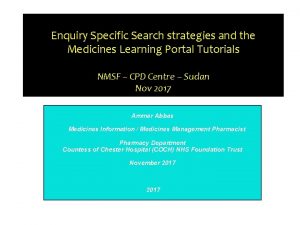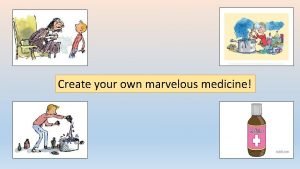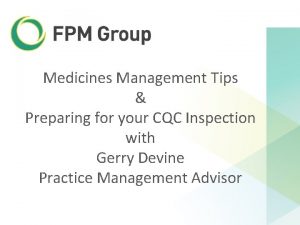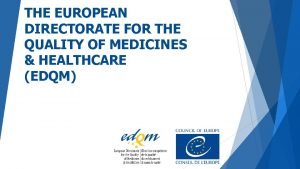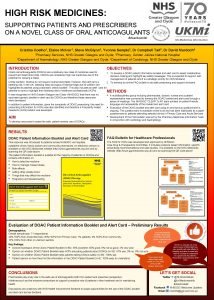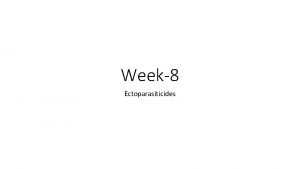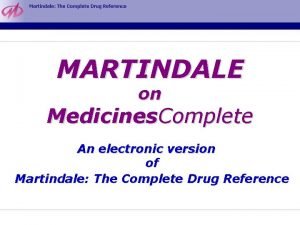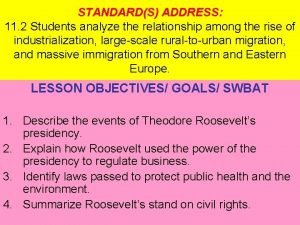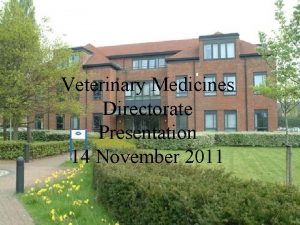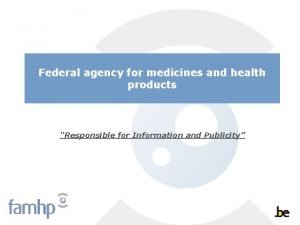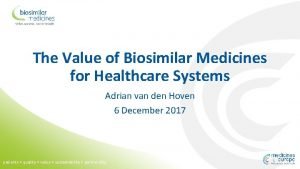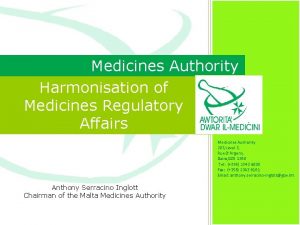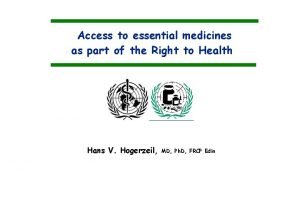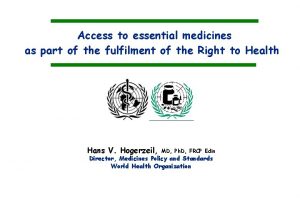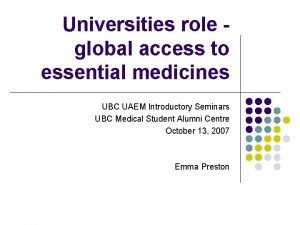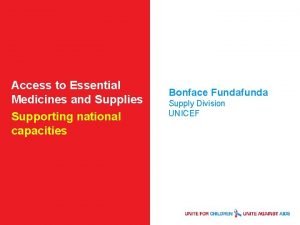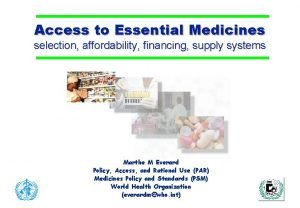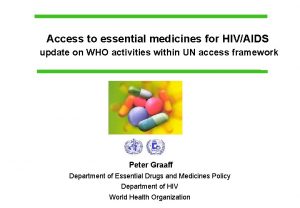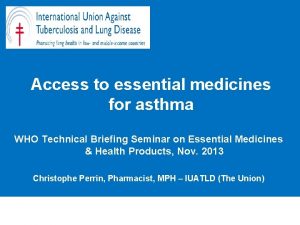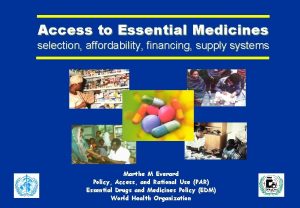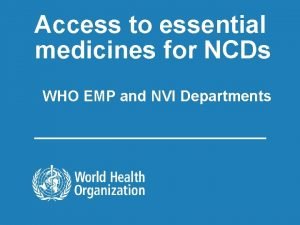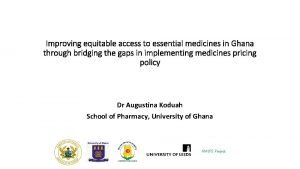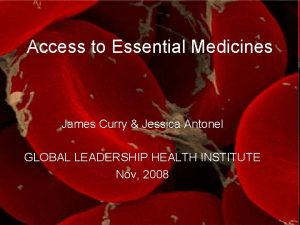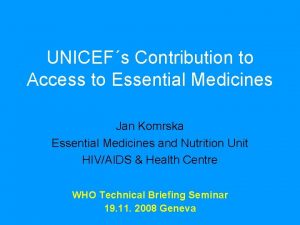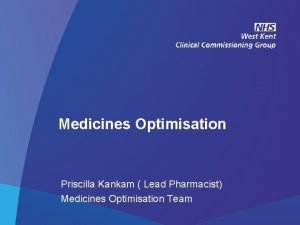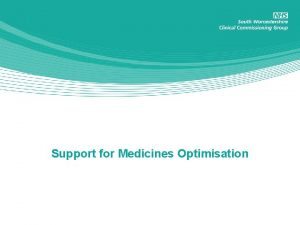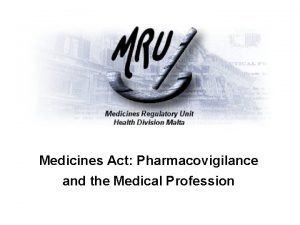Access to essential medicines as part of the




























- Slides: 28

Access to essential medicines as part of the Right to Health Hans V. Hogerzeil, MD, Ph. D, FRCP Edin Director, Essential Medicines and Pharmaceutical Policies World Health Organization, Geneva October 2010

Overview of the presentation n n The Right to Health: principles and legal instruments Is access enforceable through the courts? Rights-based approach in medicine programmes: Five practical points to check Practical recommendations to governments The way forward: n Access to essential medicines as indicator for government commitment to the Right to Health 2 Access to Essential Medicines as part of Human Rights

Human Rights: n concern the relation the between state and the individual lead to state obligations and individual entitlements n are interdependent and interrelated n ä n n Examples in recent UN assessment: Right to: life, liberty/security of person, food, health, freedom from torture, participate in public affairs, education, housing, social security, work, freedom of expression, fair trial are based on freedom from discrimination Rights imply duties, duties demand accountability Promotion of human rights is a principle purpose of the UN 3 Access to Essential Medicines as part of Human Rights

First expression of the right to health: The WHO Constitution (1946) “The States parties to this Constitution declare, in conformity with the Charter of the United Nations, that the following principles are basic to the happiness, harmonious relations and security of all peoples. Health is a state of complete physical, mental and social well-being and not merely the absence of disease or infirmity. The enjoyment of the highest attainable standard of health is one of the fundamental rights of every human being without distinction of race, religion, political belief, economic or social condition (. . . )” The right to the highest attainable standard of health = "Right to Health" 4 Access to Essential Medicines as part of Human Rights

Universal Declaration of Human Rights (1948) Art. 25. 1 “Everyone has the right to a standard of living adequate for the health of himself and of his family, including food, clothing, housing and medical care and necessary social services” 5 Access to Essential Medicines as part of Human Rights

The "Right to Health" is also recognized in numerous other legal instruments 1961 European Social Charter 1966 International Covenant on Economics, Social and Cultural Rights (most detailed; Article 12. 1 and 12. 2) 1978 Declaration of Alma. Legally Ata binding 1981 African Charter on Human and People’s Rights 1988 Additional Protocol to the American Convention on HRs in the Area of Economic, Social and Cultural Rights 1989 Convention on the Rights of the Child 6 Access to Essential Medicines as part of Human Rights

Up above the world (1966) Paul Bowles ". . But what does the term "human rights" mean? The American idea is based completely on the fact that Americans have always had more than their share… Put them in the same position as the rest of the people in the world, and they'll understand soon enough that what they've had so far have been only privileges, not rights. " 7 Access to Essential Medicines as part of Human Rights

International Covenant on Economics, Social and Cultural Rights (ratified by 157 countries) Lega Article 12 recognizes the n “right of everyone to the enjoyment of the highest attainable standard of physical and mental health” Article 12. 2 illustrates a number of n steps to be taken by States parties to achieve: ä ä a. maternal, child and reproductive health b. healthy natural and workplace environments c. prevention, treatment and control of disease d. health facilities, goods and services 8 Access to Essential Medicines as part of Human Rights g l din n i b ly

Committee on Economic, Social and Cultural Rights General Comment nr. 14 (May 2000) ve itati r o h t u Art. 12. 2. c: ly a h g i H Right to prevention, treatment and control of diseases includes creation of a system of urgent medical care in case of accidents, epidemics; and disaster relief and humanitarian assistance Art 12. 2. d: Right to health facilities, goods and services includes appropriate treatment of prevalent diseases, preferably at community level; and the provision of essential drugs as defined by the WHO Action Programme on Essential Drugs 9 Access to Essential Medicines as part of Human Rights

Access to essential drugs as a Human Right: Where are we now? n n Health is a human right (WHO 1946, Univ. Decl. Human Rights 1948). The right to health care includes the right to emergency care and health facilities, goods and services (Intern. Covenant, 1966) The right to facilities, good and services includes the provision of essential drugs as defined by WHO (GCom. 14, 2000) State parties are under immediate obligation to guarantee that the right to health care is exercised without discrimination, and that concrete steps are taken towards full realization, with emphasis on vulnerable and marginal groups 11 Access to Essential Medicines as part of Human Rights

All governments have signed at least one international human rights treaty or have a Constitution recognizing the Right to Health Source: Eleanor D. Kinney: The International Human Right to Health: What does this mean for our nation and world? Indiana Law Review, 200; 34: 1465. Quoted in: 25 Questions and answers on health and human rights, WHO, 2002 12 Access to Essential Medicines as part of Human Rights

So what? 13 Access to Essential Medicines as part of Human Rights

Is access to essential medicines as part of the Right to Health enforceable through the courts? Hogerzeil HV, Samson M, Vidal Casanova J, Rahmani L (Lancet 2006) Objective To identify and analyze court cases from low- and middle income countries, in which individuals/groups have claimed access to essential medicines on the basis of human right treaties signed by the State Results 71 cases from 12 countries • 59 won, 12 lost • half deal with HIV/AIDS; others with leukemia, diabetes, renal dialysis • 38% public interest cases • 20% supported by NGOs • 93% of successful cases from Latin America (rest from India, S. Africa, Nigeria) 14 Access to Essential Medicines as part of Human Rights

Main findings in 59 successful cases (Argentina, Bolivia, Brazil, Colombia, C. Rica, Ecuador, India, S. Salvador, S. Africa, Venezuela) n Success often linked to: ä ä ä Constitutional provisions supported by human rights treaties Link between right to health and right to life (66% life-savings EMs) Legal, financial and advocacy support by public interest NGOs n Individual cases have generated group rights n Right to health is not restricted by limits in social security ä ä n Government policies can successfully be challenged in court ä n Acquired rights, time restrictions in coverage Essential medicines not (yet) included in social security Discrimination, lack of progress Court decisions on selection of EMs for reimbursement ä Missing essential medicines, expensive EMs, branded/new products 15 Access to Essential Medicines as part of Human Rights

Good or bad? Human rights and essential medicine lists n C. Rica: ARVs which were not on EML / Social Security n C. Rica: Branded product (while generic in Social Security) C. Rica: Leukemia medicine, excluded (too expensive) Colombia: Medicines not included in Social Security Brazil: 3500 court cases pending for medicines not included in Social Security; just registered; not registered in Brazil n n n ä ä ä Nearly always awarded; MOH funds immediately blocked MOH now loses about 25% of medicine budget Toll-free number to call for toll-free lawyer 16 Access to Essential Medicines as part of Human Rights

Conclusion of WHO study n n Many governments have made international and/or constitutional obligations on the right to health. Skilful litigation can provide an additional mechanism towards ensuring that these obligations or fulfilled. Success is possible and this should encourage others. Health policy makers and the public health community should be aware of the increasing trend towards litigation. Rather than the judiciary deciding over who should have access to which medicines, policy makers should ensure that human rights standards guide their health policies and plans from the start. 17 Access to Essential Medicines as part of Human Rights

Rights-based approach in medicines: What makes it better than a good essential medicines programme? Hogerzeil HV, WHO Bulletin, May 2006 General approach: n Check the WHO publication "25 Questions of the Right to Health" for practical implications in the case of essential medicines General recommendation: n Human rights should define the framework for development in the medicines area. The attainment of the highest attainable standard of health must be the stated objective of the national medicine policy 18 Access to Essential Medicines as part of Human Rights

1: Which medicines are covered by the right to health? Practical implications n n Does the constitution guarantee the right of everyone to the enjoyment of the highest attainable standard of health? Do national laws/regulations further define the Right to Health, social security, services and medicines covered? Has the national list of essential medicines been updated in the last two years? Outside scope of national governments (refugee camps, ships): WHO/UN lists apply Discussion question: Is the WHO Model List a Moral Minimum? 20 Access to Essential Medicines as part of Human Rights

Have all beneficiaries of the medicine programme been consulted? 2: n In developing a national medicine policy and implementation plan, the usual partners are the Ministry of Health, government departments, missions, academia, industry, professional associations n What about: ä ä Rural communities, local governments Public interest NGOs Patient and consumer groups Representatives of vulnerable groups, ethnic minorities? 21 Access to Essential Medicines as part of Human Rights

3. Are there mechanisms for transparency and accountability? n n Transparent statement on government obligations, in line with international treaties National medicine policy with clear identification of roles and responsibilities of government departments and other stakeholders Indicators, baseline date and targets identified and used to monitor progressive realization of access to essential medicines Mechanisms to hold stakeholders accountable 22 Access to Essential Medicines as part of Human Rights

4. Do all vulnerable groups have equal access to essential medicines? How do you know? n n Vulnerable groups: children (girls), women, people living in poverty, rural communities, indigenous populations, national (ethnic, religious, linguistic) minorities, internally displaced persons, elderly, disabled, prisoners First step: collect disaggregated statistics on access ä ä ä n Awareness among policy makers Identify vulnerable groups which need special attention Monitor progress towards universal access Absolute minimum: gender-disaggregated statistics and incidental surveys aimed at specific vulnerable groups 23 Access to Essential Medicines as part of Human Rights

5. Are there safeguards and redress mechanisms in case human rights are violated? n n n Access to essential medicines is best achieved and guaranteed by the rights-based approach in national medicines policies and programmes In case of slow progress, regression, discrimination: redress and appeal mechanisms are needed as last resort Careful litigation has been helpful to encourage governments to fulfil their constitutional and international obligations (WHO study in 12 developing countries) 24 Access to Essential Medicines as part of Human Rights

Practical recommendations to governments n Ensure constitutional endorsement of the right to health, the right to life and the right to non-discrimination; n Specify government obligations in social welfare, provision of health care services and access to essential medicines, with emphasis on vulnerable groups; endorse selection of essential medicines by social security Incorporate rights-based approach in national medicine policies Collect disaggregated statistics, monitor access by gender and vulnerable groups n n n Create legal instruments for enforcement and redress n Report regularly on progressive realization of right to health 25 Access to Essential Medicines as part of Human Rights

Access to Essential Medicines becomes an indicator for government commitment n n n WHO includes country constitutional commitment towards right to health in Medium Term Strategic Plan indicators WHO/EMP includes country constitutional commitment as indicator for access to essential medicines UN publishes set of 12 Human Right indicators, as model for country reporting on ä ä n Political and civil rights (e. g. freedom of association) Economic, cultural and social rights (e. g. right to education, right to housing, right to health) Lancet publishes independent assessment of country progress towards the right to health (Nov 2008) Source: United Nations, HRI/MC/2008/3 27 Access to Essential Medicines as part of Human Rights

Example 1: Standard set of indicators for measuring access, as defined for WHO/MTSP, UNDP/MDG 8 Gap Analysis, and Lancet assessment Government commitment: n Access to essential medicines/technologies as part of the fulfillment of the right to health, recognized in the constitution or national legislation (S) n Existence and year of a published national medicines policy (S) Rational selection: n Existence and year of a published national list of essential medicines (S) Affordable prices: n Legal provisions to allow/encourage generic substitution in private sector (S) n Median consumer price ratio of 30 selected EMs in pub/private facilities (P) n Percentage mark-up between manufacturers' and consumer price (P) Sustainable financing: n Public and private per capita expenditure on medicines (P) n % of population covered by national health service or health insurance (P) Reliable systems: n Average availability of 30 selected EMs in public/private health facilities (O) 28 Access to Essential Medicines as part of Human Rights

Example 2: (June 2008, S. K. Perehudoff) Legal indicators for national commitment 193 135 89 Constitutions, 187 can be accessed Include the Right to Health Mention health facilities, goods and services 4 Include (essential) medicines Peru (1972, 1994) Philippines (1987) Syria (1973) Mexico (1917) Outcomes: WHO/MTSP baseline and indicator; Checklist and "Best practice" text for future use 29 Access to Essential Medicines as part of Human Rights

Good example of Constitution and Action Plan: South Africa Constitution (1994, amended 2003) 1. Everyone has the right to have access to health-care services, including reproductive health care, sufficient food and water and social security, including, if they are unable to support themselves and their dependants, appropriate social assistance 2. The State must take reasonable legislative and other measures, within its available resources, to achieve the progressive realization of each of these rights No one may be refused emergency treatment 3. National action plan for the protection and promotion of human rights (1998) n Recognition of the fact that the realization of socioeconomic rights requires public expenditure to meet basic needs, develop infrastructure, promote growth and stimulate job creation. 31 Access to Essential Medicines as part of Human Rights

Saving lives with the right (to) medicines www. who. int / medicines 33 Access to Essential Medicines as part of Human Rights
 Essential non essential fatty acids
Essential non essential fatty acids Pharmac pharmaceutical schedule
Pharmac pharmaceutical schedule Nhs dictionary of medicines and devices
Nhs dictionary of medicines and devices Chapter 19 lesson 2 using medicines safely
Chapter 19 lesson 2 using medicines safely Medicines complete
Medicines complete Niyog-niyogan treatment
Niyog-niyogan treatment National medicines policy
National medicines policy Stockley’s drug interaction
Stockley’s drug interaction George's marvellous medicine story
George's marvellous medicine story Medicines information centre
Medicines information centre Cqc medicines management
Cqc medicines management European directorate for the quality of medicines
European directorate for the quality of medicines Ggc medicines
Ggc medicines Ectoparasiticides veterinary medicines
Ectoparasiticides veterinary medicines Refrigerant management program
Refrigerant management program Medicinescomplete martindale
Medicinescomplete martindale Square deal
Square deal Veterinary medicines directorate
Veterinary medicines directorate Federal agency for medicines and health products
Federal agency for medicines and health products European medicines agency
European medicines agency Which type of drug are distributed by the envelope method
Which type of drug are distributed by the envelope method Essential parts of business letter
Essential parts of business letter Terminal access controller access control system
Terminal access controller access control system Terminal access controller access-control system
Terminal access controller access-control system Các loại đột biến cấu trúc nhiễm sắc thể
Các loại đột biến cấu trúc nhiễm sắc thể Vẽ hình chiếu đứng bằng cạnh của vật thể
Vẽ hình chiếu đứng bằng cạnh của vật thể độ dài liên kết
độ dài liên kết Các môn thể thao bắt đầu bằng tiếng nhảy
Các môn thể thao bắt đầu bằng tiếng nhảy Chó sói
Chó sói

